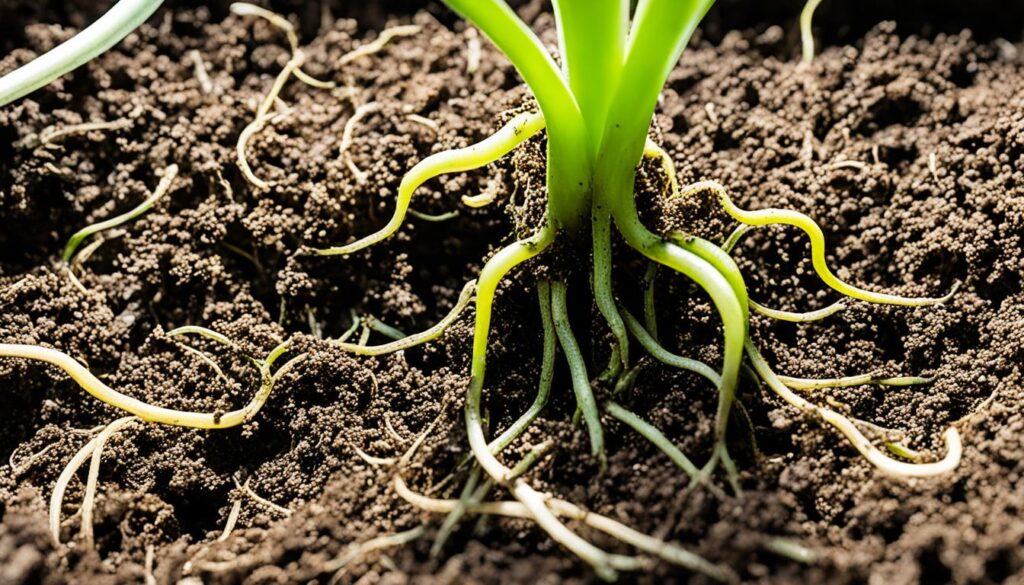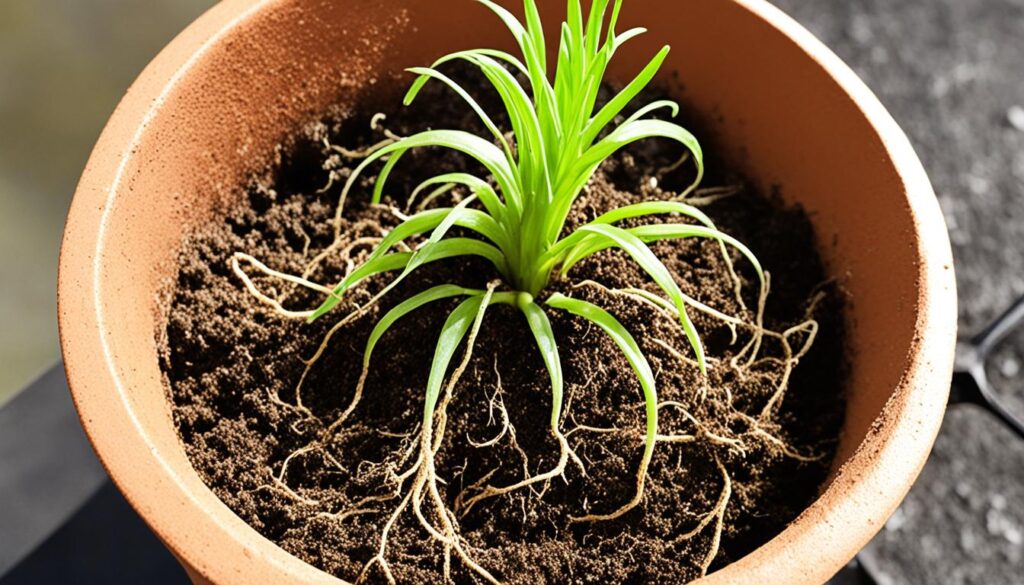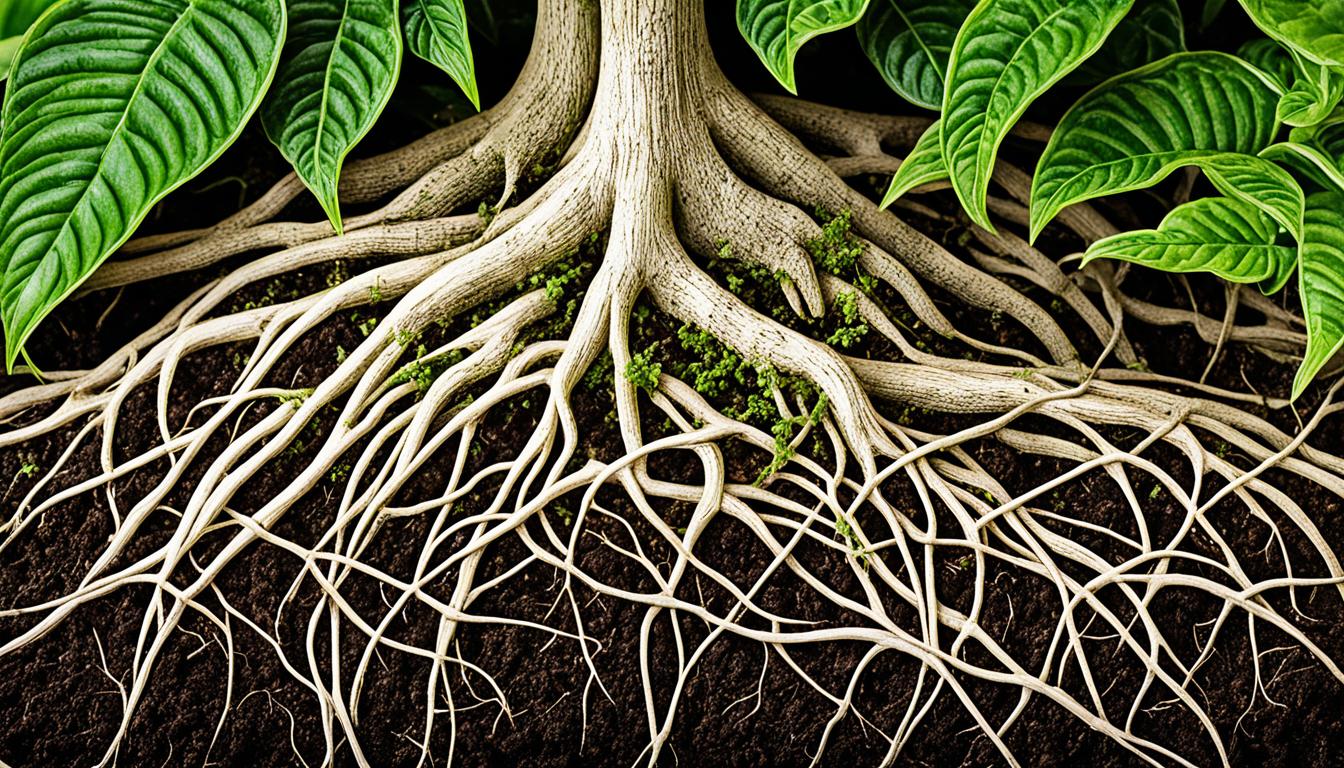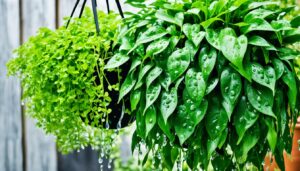Have you ever wondered why some houseplants thrive effortlessly while others struggle to survive, despite receiving the same care? The secret might just lie beneath the soil. Are you giving your plant roots the attention they deserve?
When it comes to maintaining healthy houseplants, many people focus solely on the leaves, stems, and flowers. However, the health and vitality of a plant truly start with its roots. The roots act as the foundation, providing support and absorbing essential nutrients and water for the plant’s overall growth and well-being.
By understanding the importance of root care and implementing a few key tips, you can ensure that your houseplants thrive and flourish. From choosing the right potting mix to watering techniques and preventing root problems, every aspect contributes to the health of your plant’s roots.
In this article, we will explore the essential techniques and practices for nurturing healthy houseplant roots. By giving your roots the attention they deserve, you can create an ideal environment for your plants to grow, thrive, and enhance the beauty of your indoor space.
Key Takeaways:
- Caring for your houseplants’ roots is essential for their overall health and growth.
- Choosing the right potting mix and pots can greatly impact root health.
- Proper watering techniques and drainage are crucial for preventing root problems.
- Fertilizing and ensuring adequate aeration and oxygenation contribute to strong and healthy roots.
- By implementing these tips, you can create an optimal environment for your houseplant roots to thrive.
Introduction
Having healthy roots is crucial for the overall health and growth of your indoor plants. The roots of houseplants play a vital role in absorbing water and nutrients, providing stability, and supporting the plant’s overall structure. By focusing on root care, you can ensure that your plants thrive and flourish in their indoor environment.
In this article, we will explore essential tips for maintaining healthy houseplant roots and discuss the importance of root care for your indoor plants. By following these tips, you can create a nurturing environment that promotes strong and robust root systems, leading to healthy and vibrant plants.
Throughout this article, we will cover topics such as understanding plant roots, choosing the right potting mix, selecting the perfect pot, watering techniques for root health, preventing and treating root problems, fertilizing for strong roots, and ensuring proper aeration and drainage for optimal root function.
Let’s dive into the world of root care and discover the key practices that will benefit your indoor plants.
Next, we will explore the structure and functions of plant roots in more detail.
Understanding Plant Roots
Plant roots play a vital role in the overall health and growth of plants. They are responsible for providing support, absorbing water and nutrients, and anchoring the plant securely in the soil. Understanding the structure and functions of plant roots is crucial for ensuring the health and longevity of your houseplants.
The structure of plant roots can vary depending on the type of plant. Generally, they consist of several main parts:
- Root Cap: The root cap is located at the tip of the root and protects the growing tissues as they push through the soil.
- Meristem: The meristem is the region of actively dividing cells responsible for root growth and development.
- Primary Root: The primary root is the first root that emerges from the seed and serves as the main structural support.
- Lateral Roots: Lateral roots branch off from the primary root and serve as additional anchors and nutrient absorbers.
- Root Hairs: Root hairs are tiny projections on the surface of the roots that greatly increase the surface area for water and nutrient absorption.
The functions of plant roots are multifaceted and essential for plant survival. Here are some key roles performed by plant roots:
- Water Absorption: Plant roots absorb water from the soil, allowing the plant to maintain proper hydration and carry out various metabolic activities.
- Nutrient Absorption: Roots also absorb essential nutrients such as nitrogen, phosphorus, and potassium from the soil, which are crucial for plant growth and development.
- Anchorage and Support: The root system provides stability to plants by anchoring them in the ground, preventing them from toppling over in strong winds or heavy rain.
- Storage: Roots can store carbohydrates and other nutrients, serving as a reservoir to sustain the plant during periods of stress or dormancy.
- Interaction with Soil Microorganisms: Plant roots create a symbiotic relationship with beneficial soil microorganisms, exchanging nutrients and promoting a healthy soil ecosystem.
The importance of root health cannot be overstated. Healthy roots are the foundation for a thriving plant. When roots are strong and healthy, they can efficiently absorb water and nutrients, leading to vigorous growth and blooming. On the other hand, root problems such as root rot or nutrient deficiencies can severely inhibit plant growth and even lead to the death of the plant.
To ensure the health of your houseplants, it is imperative to pay attention to the well-being of their roots. By understanding the structure and functions of plant roots and implementing techniques to maintain root health, you can provide the foundation for your plants to flourish.

Choosing the Right Potting Mix
When it comes to cultivating healthy houseplant roots, selecting the right potting mix is crucial. The potting soil you choose plays a vital role in providing the necessary nutrients, moisture retention, and drainage for optimal root health. By opting for the appropriate potting mix, you can ensure that your houseplants thrive and grow vigorously.
There are various types of potting mixes available in the market, each offering unique benefits for root health. Organic potting mixes, for example, are an excellent choice for those looking to prioritize natural and sustainable gardening practices. These mixes are enriched with organic matter, which supports the development of robust and healthy roots.
When selecting a potting mix, it’s essential to consider the specific requirements of your houseplants. Different plants have different needs, so it’s crucial to choose a mix that aligns with their preferences. For example, succulents and cacti thrive in well-draining potting mixes that provide excellent airflow to the roots, preventing waterlogged conditions.

On the other hand, tropical plants and leafy greens prefer potting mixes that retain moisture for longer periods. These mixes typically contain ingredients like peat moss or coconut coir, which help retain water and provide a consistent moisture level for the roots.
It’s also important to consider the nutrient content of the potting mix. Look for mixes that contain a balanced blend of nutrients to support root growth and plant health. Some potting soil mixes come with added fertilizers or slow-release nutrients, which can provide a steady supply of essential elements for your plants.
In summary, selecting the right potting mix is essential for promoting healthy root development in your houseplants. Whether you opt for organic potting mixes or specific blends for different plant types, ensure that the mix provides adequate drainage, moisture retention, and nutrient content.
Selecting the Perfect Pot
When it comes to cultivating healthy roots for your beloved houseplants, choosing the right pot is an essential step to consider. The selection of a plant pot can have a significant impact on the overall health and growth of the roots.
There are various types of pots available in the market, each with its own advantages and disadvantages. Let’s delve into the different options:
- Terra cotta pots: These pots are made from clay and are porous, allowing air and moisture to pass through. They provide good drainage and prevent waterlogged soil, which can cause root rot. However, they can dry out quickly, requiring more frequent watering.
- Plastic pots: Plastic pots are lightweight and easy to handle. They retain moisture for a longer time, reducing the frequency of watering. However, they may not provide adequate drainage, leading to waterlogged soil and suffocating roots if proper care is not taken.
- Ceramic pots: Ceramic pots come in various designs and colors, adding aesthetic appeal to your indoor space. They are heavy and provide good stability for larger plants. However, they are not as breathable as terra cotta pots and may require a drainage hole.
- Fabric pots: Fabric pots are becoming increasingly popular as they provide excellent drainage and allow air to reach the roots. They prevent the accumulation of excess moisture, reducing the risk of root diseases. However, they may require more frequent watering as they dry out faster.
- Self-watering pots: These innovative pots have a reservoir that stores water, allowing the plant to draw moisture as needed. They provide a consistent water supply, reducing the risk of under or overwatering. However, it is crucial to monitor the water level to prevent root rot.
Remember, regardless of the pot type you choose, proper drainage is key to maintaining healthy roots. Ensure that your pots have drainage holes to allow excess water to escape, preventing waterlogged soil and promoting root health.

Watering Techniques for Root Health
Proper watering is crucial for maintaining healthy roots in your houseplants. Overwatering and underwatering are common mistakes that can lead to root rot and hinder plant growth. By mastering the art of watering, you can ensure optimal root health and overall plant vitality.
“Watering is the key to a plant’s well-being. It’s important to strike the right balance to avoid water-related issues.”
There are different watering techniques you can employ to promote healthy roots:
- Check moisture levels: Before watering, assess the moisture level of the soil. Stick your finger about an inch deep into the soil. If it feels dry at that depth, it’s time to water.
- Water deeply: When watering, make sure to water deeply. This encourages roots to grow deeper into the soil, improving their overall health and resilience.
- Use the right amount of water: Avoid overwatering by using the appropriate amount of water for each plant. Some plants require more frequent watering, while others prefer a drier environment.
- Consider the type of plant: Different plants have different watering needs. Research the specific requirements of your houseplants to ensure you provide the right amount of water.
“Proper watering techniques can help prevent root diseases and ensure your houseplants thrive.”
Remember, overwatering can suffocate the roots, while underwatering may cause them to dry out and become ineffective in nutrient absorption. By following these watering techniques, you can maintain the perfect balance and promote healthy roots in your houseplants.
Preventing and Treating Root Problems
Root problems in houseplants can arise due to various factors, but with proper care and attention, they can be prevented and treated effectively. By understanding the common root issues, recognizing the signs, and implementing the right techniques, you can ensure the health and vitality of your houseplant roots.
Diagnosing root issues is crucial for addressing the underlying problems. Some signs of root problems include wilting leaves, yellowing foliage, stunted growth, and a foul smell emanating from the soil. To confirm the presence of root issues, gently remove the plant from its pot and inspect the roots. Healthy roots should be firm, white, and abundant, while unhealthy roots may appear mushy, brown, or decayed.
To prevent root problems, ensure proper watering practices by allowing the top inch of soil to dry out before watering again and avoiding overwatering. Additionally, provide sufficient drainage by using pots with drainage holes and using well-draining potting mix.
If root rot is detected, it is important to take immediate action to treat the issue. Start by removing the affected parts of the roots using clean, sterilized scissors or shears. Then, replant the houseplant in fresh, well-draining soil and a clean pot. Adjust your watering routine to prevent excess moisture and promote root recovery.
By being proactive in preventing root problems and taking prompt action when issues arise, you can ensure the long-term health and success of your houseplants.
Fertilizing for Strong Roots
Proper fertilization is essential for promoting strong and healthy roots in your houseplants. By providing the right nutrients, you can support root growth and ensure the overall health and vitality of your plants. Let’s explore the importance of fertilizing for root development, the essential plant nutrients needed, and some tips for balanced fertilization.
Importance of Proper Fertilization
Fertilization plays a crucial role in root health and growth. When plants receive the necessary nutrients, they can develop strong and robust root systems. Fertilizers provide essential elements like nitrogen, phosphorus, and potassium that plants need to thrive. These nutrients are vital for root development, nutrient absorption, and overall plant vigor.
Essential Nutrients for Root Development
When choosing a fertilizer for root growth, it’s important to consider the three main nutrients: nitrogen (N), phosphorus (P), and potassium (K). Nitrogen promotes foliage growth, phosphorus supports root development and flowering, and potassium aids in overall plant health, including root growth and disease resistance. Look for fertilizers with a balanced N-P-K ratio to ensure your plants receive all the necessary nutrients for healthy roots.
Tips for Balanced Fertilization
To achieve balanced fertilization and promote strong roots, keep the following tips in mind:
- Follow the instructions: Read the fertilizer label carefully and follow the recommended application rates and frequencies. Applying too much fertilizer can lead to nutrient imbalances or root burn, while under-fertilization may result in nutrient deficiencies.
- Fertilize during active growth: Apply fertilizer when your plants are actively growing to ensure they can effectively absorb and utilize the nutrients. Avoid fertilizing during dormancy periods.
- Use slow-release fertilizers: Slow-release fertilizers gradually release nutrients over time, providing a steady and balanced supply for root growth. This reduces the risk of over-fertilization and minimizes nutrient leaching.
- Monitor plant response: Pay attention to how your plants respond to fertilization. If you notice signs of nutrient deficiencies or excessive growth, adjust your fertilization routine accordingly.
| Nutrient | Role | Sources |
|---|---|---|
| Nitrogen (N) | Promotes foliage growth | Fish emulsion, blood meal, compost |
| Phosphorus (P) | Supports root development and flowering | Bone meal, rock phosphate, bat guano |
| Potassium (K) | Aids in overall plant health, including root growth | Wood ash, kelp meal, greensand |
Aeration and Drainage
Proper aeration and drainage are crucial for the health and vitality of plant roots. Adequate oxygenation is essential for root development and nutrient uptake. Insufficient oxygen levels can lead to root suffocation and hinder plant growth. Additionally, ensuring proper drainage helps prevent root rot and other issues caused by waterlogged soil.
To improve root oxygenation, consider implementing the following techniques:
1. Loosening the soil: Gently loosen the top layer of soil around your plants to promote better air circulation and root development.
2. Mulching: Apply a layer of organic mulch, such as wood chips or straw, around the base of plants. This helps regulate soil temperature, retain moisture, and improve aeration.
3. Avoid compacting the soil: Be mindful of heavy foot traffic around plants, as compacted soil limits the movement of air and water.
Alongside aeration, proper drainage is crucial for root health. Excess water in the soil can lead to root rot and other issues. Here are a few tips to ensure adequate drainage:
- Choose pots with drainage holes to allow excess water to escape.
- Use well-draining potting mixes that allow water to flow freely through the soil.
- Avoid overwatering your plants. Only water when the top inch of soil feels dry to the touch.
- Consider using pot feet or placing pots on a layer of gravel to elevate them slightly and improve drainage.
By implementing proper aeration techniques and ensuring adequate drainage, you can create an optimal environment for your plant roots, promoting healthier growth and overall plant vitality.
| Aeration Techniques | Benefits |
|---|---|
| Loosening the soil | Improves air circulation and root development |
| Mulching | Regulates soil temperature and retains moisture |
| Avoiding soil compaction | Facilitates air and water movement in the soil |
Conclusion
As we wrap up this journey into the world of healthy houseplant roots, it’s important to remember the key takeaways for maintaining thriving indoor plants. Root care is the foundation for overall plant health and growth, and investing time and effort into nurturing your plant’s roots will yield rewarding results.
We’ve explored the significance of choosing the right potting mix and plant pot, as well as the importance of proper watering techniques and drainage. By ensuring your plants receive the right nutrients through fertilization, you can promote strong and healthy roots. Additionally, providing adequate aeration and preventing root problems such as rot are essential for maximizing root health.
We encourage you to implement the tips and techniques shared throughout this article. By prioritizing root care, you’ll set your indoor plants up for success and enjoy the beauty and benefits they bring to your home. Remember to be mindful of the specific needs of each plant species, and don’t hesitate to seek further advice if you encounter any challenges along the way.
By cultivating healthy houseplant roots, you’re creating an optimal environment for your beloved plant companions to thrive and flourish. So, roll up your sleeves, grab your gardening tools, and embark on this fulfilling journey of caring for your indoor plants from the roots up. Your efforts will be rewarded with vibrant, lush foliage and a sense of fulfillment in your gardening endeavors.
FAQ
Why is root care important for houseplants?
Root care is essential for houseplants because healthy roots are the foundation for overall plant health and growth. By investing time and effort into caring for the roots, you can ensure that your houseplants thrive and flourish.
What are the different types of roots and their significance?
There are various types of roots, including taproots, fibrous roots, and adventitious roots. Taproots go straight downwards, fibrous roots spread out horizontally, and adventitious roots form from stems or leaves. Each type has its own role in providing support, absorbing water and nutrients, and anchoring the plant.
How do I choose the right potting mix for healthy roots?
When selecting a potting mix, consider the specific needs of your houseplant. Look for mixes that offer good drainage, aeration, and water retention. Organic potting mixes are often recommended as they provide essential nutrients and support root health.
What is the significance of pot selection for root health?
Choosing the right pot is crucial for root health. Clay pots allow for better aeration and drainage, which can prevent root rot. Plastic and ceramic pots hold moisture longer but may require careful monitoring of watering. Self-watering pots can be beneficial for certain plants, as they provide consistent moisture levels to the roots.
How should I water my houseplants to maintain root health?
Proper watering techniques are essential for root health. Water your houseplants thoroughly, allowing excess water to drain out of the pot. Avoid overwatering or underwatering by checking the moisture level in the soil and adjusting watering frequency accordingly. Water at the base of the plant to avoid wetting the foliage.
How can I prevent and treat root problems in houseplants?
To prevent root problems, ensure proper drainage and avoid overwatering. If you notice signs of root rot or other issues, such as yellowing leaves or a foul odor, diagnosis and treatment are necessary. Treat root rot by cutting away affected roots, repotting in fresh soil, and adjusting watering practices to prevent recurrence.
How do fertilizers contribute to root health and growth?
Fertilizers provide essential nutrients for root development. Nitrogen promotes green leafy growth, phosphorus enhances root formation, and potassium contributes to overall plant health. Balanced fertilization is key to nourishing the roots and promoting strong, healthy growth.
What are some methods for improving root oxygenation and drainage?
Improving root oxygenation and drainage can be achieved by using well-draining soil mixes, avoiding compacted soil, and creating air pockets around the roots. Additionally, adding perlite or vermiculite to the potting mix can help improve aeration. Ensuring proper drainage by using pots with drainage holes and avoiding waterlogging is also crucial.
These are examples of questions and answers you can include in the FAQ section of the article. Feel free to modify or expand upon them as needed to fit the content and structure of your article.




